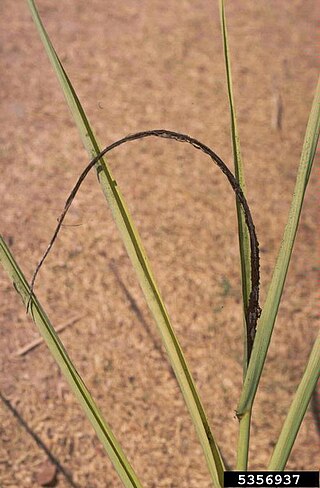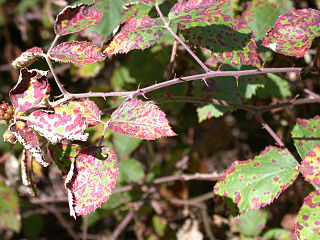
Rusts are fungal plant pathogens of the order Pucciniales causing plant fungal diseases.

Cronartium ribicola is a species of rust fungus in the family Cronartiaceae that causes the disease white pine blister rust. Other names include: Rouille vésiculeuse du pin blanc (French), white pine Blasenrost (German), moho ampolla del pino blanco (Spanish).

Sugarcane smut is a fungal disease of sugarcane caused by the fungus Sporisorium scitamineum. The disease is known as culmicolous, which describes the outgrowth of fungus of the stalk on the cane. It attacks several sugarcane species and has been reported to occur on a few other grass species as well, but not to a critical amount. The most recognizable characteristic of this disease is a black or gray growth that is referred to as a "smut whip". Resistance to sugarcane smut is the best course of action for management, but also the use of disease free seed is important. On smaller scale operations treatments using hot water and removing infected plants can be effective. The main mode of spore dispersal is the wind but the disease also spreads through the use of infected cuttings. Sugarcane smut is a devastating disease in sugarcane growing areas globally.
Barley stripe rust is a fungal disease of barley caused by Puccinia striiformis f. sp. hordei. a forma specialis of Puccinia striiformis. It was first detected in the United States in 1991, in northern and eastern Idaho in 1993, In 1995 it was detected for the first time in western Washington and western Oregon and is currently considered to be well established there. The disease initially develops at a small loci within a field and spreads rapidly and has caused significant losses in areas where climatic conditions are cool and wet.

Leptosphaeria sacchari is a plant pathogenic fungus which causes a disease called ring spot on Saccharum officinarum. This species was originally described in 1890 by Kruger and in 1892 by Van Breda de Haan after it was discovered in the Dominican Republic. L. sacchari is the applied name, whereas Epicoccum sorghinum is the accepted name.

Phragmidium violaceum is a plant pathogen native to Europe, Africa, and the Middle East. It primarily infects Rubus species.
Puccinia cacabata is a fungal species and plant pathogen that causes rust on cotton. It was originally found on the leaves of Chloris ciliata in Bolivia.
Puccinia schedonnardii is a basidiomycete fungus that affects cotton. More commonly known as a “rust,” this pathogen typically affects cotton leaves, which can decrease the quality of the boll at time of harvest. As large percentages of cotton in the United States are resistant to various rust varieties, there is little economic importance to this disease. In places where rust is prevalent, however, growers could see up to a 50% reduction in yield due to rust infection.

Albugo is a genus of plant-parasitic oomycetes. Those are not true fungi (Eumycota), although many discussions of this organism still treat it as a fungus. The taxonomy of this genus is incomplete, but several species are plant pathogens. Albugo is one of three genera currently described in the family Albuginaceae, the taxonomy of many species is still in flux.

Puccinia asparagi is the causative agent of asparagus rust. It is an autoecious fungus, meaning that all stages of its life cycle – pycniospores, aeciospores, and teliospores – all develop upon the same host plant . Rust diseases are among the most destructive plant diseases, known to cause famine following destruction of grains, vegetables, and legumes. Asparagus rust occurs wherever the plant is grown and attacks asparagus plants during and after the cutting season. Asparagus spears are usually harvested before extensive rust symptoms appear. Symptoms are first noticeable on the growing shoots in early summer as light green, oval lesions, followed by tan blister spots and black, protruding blisters later in the season. The lesions are symptoms of Puccinia asparagi during early spring, mid-summer and later summer to fall, respectively. Severe rust infections stunt or kill young asparagus shoots, causing foliage to fall prematurely, and reduce the ability of the plant to store food reserves. The Puccinia asparagi fungus accomplishes this by rust lowering the amounts of root storage metabolites. The infected plant has reduced plant vigor and yield, often leading to death in severe cases. Most rust diseases have several stages, some of which may occur on different hosts; however, in asparagus rust all the life stages occur on asparagus. Because of this, many observers mistake the different stages of the Puccinia asparagi life cycle as the presence of different diseases. The effects of Puccinia asparagi are present worldwide wherever asparagus is being grown. Asparagus rust is a serious threat to the asparagus industry.

Puccinia coronata is a plant pathogen and causal agent of oat and barley crown rust. The pathogen occurs worldwide, infecting both wild and cultivated oats. Crown rust poses a threat to barley production, because the first infections in barley occur early in the season from local inoculum. Crown rusts have evolved many different physiological races within different species in response to host resistance. Each pathogenic race can attack a specific line of plants within the species typical host. For example, there are over 290 races of P. coronata. Crops with resistant phenotypes are often released, but within a few years virulent races have arisen and P. coronata can infect them.

Puccinia helianthi is a macrocyclic and autoecious fungal plant pathogen that causes rust on sunflower. It is also known as "common rust" and "red rust" of sunflower.

Puccinia menthae is a fungal plant pathogen that causes rust on mint plants. It was originally found on the leaves of Mentha aquatica.

Puccinia recondita is a fungus species and plant pathogen belonging to the order of Pucciniales and family Pucciniaceae.

Puccinia thaliae is the causal agent of canna rust, a fungal disease of Canna. Symptoms include yellow to tan spots on the plant's leaves and stems. Initial disease symptoms will result in scattered sori, eventually covering the entirety of the leaf with coalescing postulates. Both leaf surfaces, although more predominant on the underside (abaxial) of the leaf, will show yellow to brownish spore-producing these pustulate structures, and these are the signs of the disease. Spots on the upper leaf-surface coalesce and turn to brown-to-black as the disease progresses. Infection spots will become necrotic with time, with small holes developing in older leaves. These infected leaves eventually become dry and prematurely fall.

Puccinia horiana is a species of fungus that causes chrysanthemum white rust, is a disease of plant species of the genus Chrysanthemum.

Austropuccinia is a monotypic genus of rust native to South America with the only species Austropuccinia psidii, commonly known as myrtle rust, guava rust, or ʻōhiʻa rust. It affects plants in the family Myrtaceae. It is a member of the fungal complex called the guava rust group. The spores have a distinctive yellow to orange colour, occasionally encircled by a purple ring. They are found on lesions on new growth including shoots, leaves, buds and fruits. Leaves become twisted and may die. Infections in highly susceptible species may result in the death of the host plant.
Melampsora amygdalinae is a fungal pathogen and part of the division Basidiomycota. It is known as a rust fungus that is host specific. M. amygdalinae commonly infects willows of the genus Salix. This fungus was first discovered in 1909 by Heinrich Klebahn who was a professor of soil biology in Hamburg. Neimi at el. explain how the pathogen occurs throughout the whole distribution of the host, and the small natural populations are an area of interest. This rust fungus is annual and autoecious, which references the fungus spending its entire life in a single host.

Puccinia sorghi, or common rust of maize, is a species of rust fungus that infects corn and species from the plant genus Oxalis.

Puccinia myrsiphylli is a rust fungus in the genus Puccinia, family Pucciniaceae, and is native to South Africa. It has been tested, introduced, and targeted in Australia and New Zealand as an effective biocontrol agent for Asparagus asparagoides, also known as bridal creeper.
















